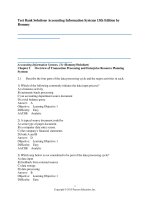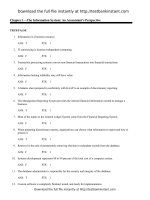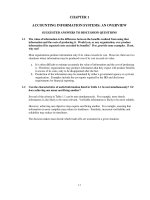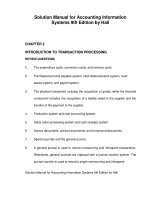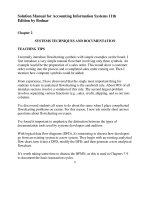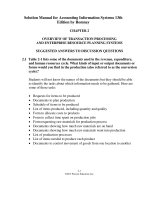Download solutions manual for accounting information systems 8th edition by hall
Bạn đang xem bản rút gọn của tài liệu. Xem và tải ngay bản đầy đủ của tài liệu tại đây (559.8 KB, 40 trang )
Solutions manual for Accounting Information Systems 8th
Edition by Hall
Link full download : />CHAPTER 2
INTRODUCTION TO TRANSACTION PROCESSING
REVIEW QUESTIONS
1.
The expenditure cycle, conversion cycle, and revenue cycle.
2.
Purchases/accounts payable system, cash disbursements system, and payroll
system.
3.
The physical component includes the acquisition of goods, while the financial
component includes the recognition of a liability owed to the supplier and the
transfer of the payment to the supplier.
4.
Production system and cost accounting system.
5.
Sales order processing system and cash receipts system.
6.
Source documents, product documents, and turnaround documents.
7.
Special journals and the general journal.
8.
A general journal is used to record nonrecurring and infrequent transactions.
Oftentimes, general journals are replaced with a journal voucher system. The
journal voucher is used to record a single nonrecurring and infrequent
transaction, and it is used as a special source document for the transaction.
The total of journal vouchers processed is equivalent to the general journal.
9.
General ledger and subsidiary ledger.
10.
A trail that allows the auditor to begin with a summary total found on the
financial statements and track it back to the individual transactions that make
up this total. Conversely, an auditor should be able to track transactions to
Chapter 2 Page 22
their final impact on the financial statements.
11.
The confirmation process entails selecting customers and contacting them to
determine whether the transactions recorded in the financial statements
actually took place and are valid.
12.
Master files, transaction files, reference files, and archive files.
13.
Master files correspond to general ledger accounts and subsidiary ledgers.
Examples include accounts receivable and customer subsidiary accounts,
accounts payable and vendor subsidiary accounts, inventory, etc. Transaction
files correspond to general and special journals. Examples include the general
journal, sales journals, cash receipts journals, payroll journals, etc. Reference
files include lists of vendors, delinquent customers, tax tables, sales tax rates,
discount rates, lists of customers granted specific discounts, etc. Archive files
are typically composed of records that have been processed but are retained
for their history. Examples include payroll transactions, sales transactions, etc.
14.
The digital audit trail, like the paper trail, allows us to trace transactions from
the financial statement balance back to the actual transaction so we may: (1)
compare balances, (2) perform reconciliations, (3) select and trace samples of
entries, and (4) identify, pull, and verify specific transactions.
15.
Cardinality reflects normal business rules as well as organizational policy. For
instance, the 1:1 cardinality in the first example in Figure 2-12 suggests that
each salesperson in the organization is assigned one automobile. If instead
the organization’s policy were to assign a single automobile to one or more
Chapter 2 Page 23
salespeople that share it, this policy would be reflected by a 1:M relationship.
16.
Entity relationship diagrams represent the relationship between entities
(resources, events, and agents) in a system. Dataflow diagrams represent the
logical elements (i.e. what is being done) of a system by illustrating
processes, data sources, data flows, and entities. System flowcharts
represent the physical elements being used (i.e., how the tasks are being
conducted) by illustrating the relationship between input sources, program,
and output products. System flowcharts can also represent both the logical
and physical elements of manual systems and also illustrate the preparation
and handling of documents.
17.
Cardinality refers to the numerical mapping between entity instances, and it is
a matter of organization policy. The relationship can be one-to-one, one-tomany, or many-to-many.
18.
An entity relationship (ER) diagram is a documentation technique used to
represent the relationship between entities. One common use for ER
diagrams is to model an organization’s database, which we examine in detail
in Chapter 9.
19.
Entities are physical resources (automobiles, cash, or inventory), events
(ordering
inventory,
receiving
cash,
shipping
goods),
and
agents
(salesperson, customer, or vendor) about which the organization wishes to
capture data.
20.
Batch processing occurs when similar transactions are accumulated over time
Chapter 2 Page 24
and processed together. Real-time processing captures each event or
transaction and processes it before engaging in another transaction. If
transactions are independent of one another, such as the processing of daily
cash receipts, then batch processing is appropriate. If transactions are
dependent on one another, such as credit sales, ticket sales, etc., then realtime processing is more appropriate.
21.
A flat-file model is one in which individual data files are not related to other
files. End users in this environment own their data files rather than share them
with other users. Data processing is thus performed by standalone
applications rather than integrated systems.
22.
No. A DFD shows which tasks are being performed, but not who performs
them. It depicts the logical system.
23.
A flowchart depicts the physical system and illustrates what type of and where
a task is performed and who is performing it.
24.
A single transaction may affect several different accounts. Some of these
accounts, however, may not need to be updated in real time. In fact, the task
of doing so takes time which, when multiplied by hundreds or thousands of
transactions, can cause significant processing delays. Batch processing of
non-critical accounts, however, improves operational efficiency by eliminating
unnecessary activities at critical points in the process.
25.
When testing an application program, the auditor needs details about its
internal logic provided by the program flowchart to design the audit tests.
Chapter 2 Page 25
26.
The system flowchart shows the relationship between two computer
programs, the files that they use, and the outputs that they produce. However,
this level of documentation does not provide the operational details that are
sometimes needed. An auditor wishing to assess the correctness of a
program’s logic cannot do so from the system flowchart. A program flowchart
provides this detail. Every program represented in a system flowchart should
have a supporting program flowchart that describes its logic.
27.
a. increased data storage since the same data is stored in multiple files
b. increased data updating since changes must be made to multiple files
c. possibility of noncurrent data caused by failure to update.
28.
Another problem with the flat-file approach is the user’s inability to obtain
additional information as his or her needs change. This problem is called taskdata dependency. The user’s information set is constrained by the data that
he or she possesses and controls. Users act independently rather than as
members of a user community. In such an environment, it is difficult to
establish a mechanism for the formal sharing of data. Therefore, new
information needs tend to be satisfied by procuring new data files. This takes
time, inhibits performance, adds to data redundancy, and drives data
management costs even higher.
29.
Organizations have overcome some of the problems associated with flat files
by implementing the database model to data management. Figure 2-13
illustrates how this approach centralizes the organization’s data into a
common database that is shared by other users. With the organization’s data
Chapter 2 Page 26
in a central location, all users have access to the data they need to achieve
their respective objectives. Access to the data resource is controlled by a
database management system (DBMS).
30.
Record layout diagrams are used to reveal the internal structure of the records
that constitute a file or database table. The layout diagram usually shows the
name, data type, and length of each attribute (or field) in the record.
31.
Updating a master file record involves changing the value of one or more of its
variable fields to reflect the effects of a transaction.
32.
The DBMS is a special software system that permits users to access
authorized data only. The user’s application program sends requests for data
to the DBMS, which validates and authorizes access to the database in
accordance with the user’s level of authority. If the user requests data that he
or she is not authorized to access, the request is denied.
33.
The flat-file approach is a single-view model. Files are structured, formatted,
and arranged to suit the specific needs of the owner or primary user of the
data. Such structuring, however, may exclude data needed by other users,
thus preventing successful integration of data across the organization.
34.
Transaction volume is the key factor. Large-scale systems that process high
volumes of transactions often use real-time data collection and batch
updating. Master file records that are unique to a transaction such as
customer accounts and individual inventory records can be updated in real
time without causing operational delays. Common accounts should be
Chapter 2 Page 27
updated in batch mode. Real-time processing is better suited to systems that
process lower transaction volumes and those that do not share common
records.
35.
In a real-time processing environment, the master files are updated as soon
as the transaction is submitted and accepted into the system. Thus, reports
are more accurate in the sense that the information is as current as possible.
Faster operational response time to customer requests such as the shipping
of an order is another, and very important, benefit. Finally, the reduction of
paper and storage space of physical source documents is another benefit.
36.
By collecting data in real time, certain transaction errors can be prevented or
detected and corrected at their source.
37. Block codes for the general ledger accounts, sequential codes for documents,
and group codes for coding transactions.
38. Sequential codes are appropriate for items in either an ascending or
descending sequence, such as the numbering of checks or source
documents. An advantage is that during batch processing, any gaps detected
in the sequence is a signal that a transaction may be missing. A disadvantage
is that the codes carry little, if any, information other than the sequence order.
Another disadvantage is that sequential codes are difficult to manage when
items need to be added; the sequence needs either to be reordered or the
items must be added to the end of the list. Block codes provide some
remedies to sequential codes by restricting each class to a
prespecified
range. The first digit typically represents a class, whereas the following digits
Chapter 2 Page 28
are sequential items which may be spaced in intervals in case of future
additions. An example of block coding is a chart of accounts. A disadvantage
of block coding is that the information content does not provide much
meaning, i.e. an account number only means something if the chart of
accounts is known. Group codes may be used to represent complex items or
events involving two or more pieces of related data. The code is comprised of
fields which possess specific meaning. The advantages of group codes over
sequential and block codes are 1. they facilitate the representation of large
amounts of diverse data, 2. they allow complex data structures to be
represented in a hierarchical form that is logical and thus more easily
remembered by humans, and 3. they permit detailed analysis and reporting
both within an item class and across different classes of items. A
disadvantage is that the codes may be overused to link classes which do not
need to be linked, and thus create a more complex coding system than is
necessary. Alphabetic codes may be used sequentially or in block or group
codes. An advantage is that a system which uses alphabetic codes can
represent far more situations than a system with numeric codes given a
specific field size. Some disadvantages are that sequentially assigned codes
mostly have little meaning. Also, humans typically find alphabetic codes more
difficult to sort than numeric data. Lastly, mnemonic codes are alphabetic
characters in the form of acronyms, abbreviations or other combinations that
convey meaning. The meaning aspect is its advantage. A disadvantage of
mnemonic codes is that they are limited in their ability to represents items
Chapter 2 Page 29
within a class (i.e. names of all of American Express’s customers).
DISCUSSION QUESTIONS
1.
Cash flows into the firm from sales made to customers. The sales order
processing subsystem of the revenue cycle captures the intent of customers
to exchange cash for services or goods manufactured. Typically sales are
made on credit. The cash receipts subsystem of the revenue cycle captures
the actual receipt of cash. Depending on the credit terms and promptness of
payment by the customer, the lag between the sales order processing
subsystem and the cash receipts subsystem may be days, weeks, or months.
The cash inflow allows the organization to purchase raw materials, pay workers, and buy
capital assets necessary to manufacture the product (or to provide services). The raw
materials requirements are determined by the production planning subsystem of the
conversion cycle. These requirements trigger orders being placed through the
purchases/accounts payable subsystem of the expenditure cycle. For credit sales, the
cash is ultimately released once the goods are received (or services are performed) and
an invoice has been received. The lag between receiving goods and disbursement of
cash may be days or weeks. Cash is also disbursed to employees, typically after services
are rendered by the employees. The lag is usually no more than one-half a month for
salaried employees and as short as one-half a week for hourly wage earners. The payroll
subsystem of the expenditure system captures these disbursements to employees.
2.
Initially, the cost accounting system was used for the valuation of inventory
Chapter 2 Page 30
and cost of goods sold reported to external users; however, the valuable use
of cost accounting data for budgeting, cost control, performance reporting,
and management decision making have proved to be crucial internal support.
3.
The conversion cycle activities for service and retailing entities include
planning the items to purchase or the services to produce, planning the
workforce to accomplish the necessary tasks (extremely crucial in service
entities), and directing the workforce in performing the service or selling the
good.
4.
Yes. For example, the remittance advice of a bill that is returned with the
payment serves as a source document for the cash receipts transaction
processing system. Thus, the product document becomes a source
document.
5.
This type of transaction is recorded in the general journal since it is
nonrecurring, infrequent, and not similar to other types of transactions.
6.
Sometimes the terms are used interchangeably, such as the sales journal is
sometimes called the sales register. The term journal is appropriate when the
information needs to be ultimately posted to the general ledger. Registers may
be used to keep logs of information that may support, but do not specifically
get posted to the general ledger, such as a raw materials receipts register or a
shipping log.
7.
The balance in the general ledger is considered a control account. This
amount is an aggregated number representing the total amount owed to
Chapter 2 Page 31
creditors listed in the accounts payable journal. The accounts payable
subsidiary ledger details the exact amount owed to each creditor. The sum of
the amounts owed to each creditor listed in the accounts payable journal
should equal the corresponding control total in the general ledger. Thus, the
accounts payable subsidiary ledger is a detailed breakdown of the summary
control total of accounts payable in the general ledger.
8.
Confirmation is most typically used for confirming the accounts receivable
account as reported on the balance sheet. The audit trail is used to trace from
the general ledger accounts receivable control account to the subsidiary
account, and then to specific customer accounts. A sample of the customer
accounts is then selected for confirmation.
9.
In theory, the magnetic audit trail functions the same as a manual audit trail. In
practice, the steps are slightly different. The archive file that consists solely of
valid transactions is the file to which the accounts receivable subsidiary
account balances and transactions are traced. The customers still need to be
contacted for confirmation.
10.
Small batches have the advantage of fewer transactions to sort through for
error detection, but they are not processed as efficiently. Further, computing
facilities and constraints might dictate whether multiple small batches may be
processed throughout the day or whether a single large batch is processed at
night when the computing facilities have excess capacity. (Multiple small
batches may still be processed in the evening.)
11.
Not all modern organizations use entirely modern information systems. Some
Chapter 2 Page 32
firms employ legacy systems for certain aspects of their data processing.
When legacy systems are used to process financially significant transactions,
auditors need to know how to evaluate and test them.
12.
Large-scale systems that process high volumes of transactions often use realtime data collection and batch updating. Master file records that are unique to
a transaction, such as customer accounts and individual inventory records,
can be updated in real time without causing operational delays. Common
accounts should be updated in batch mode. Real-time processing is better
suited to systems that process lower transaction volumes and those that do
not share common records.
13.
Real-time processing is better suited to systems that process lower
transaction volumes and those that do not share common records.
14.
The most striking difference between the database model and the flat-file
model is the pooling of data into a common database that all organizational
users share.
15.
The flat-file approach is a single-view model. Files are structured, formatted,
and arranged to suit the specific needs of the owner or primary user of the
data. Such structuring, however, may exclude data needed by other users,
thus preventing successful integration of data across the organization. For
example, because the accounting function is the primary user of accounting
data, these data are often captured, formatted, and stored to accommodate
financial reporting and generally accepted accounting principles(GAAP). This
structure, however, may be useless to the organization’s other
Chapter 2 Page 33
(nonaccounting) users of accounting data such as the marketing, finance,
production, and engineering functions. These users are presented with three
options: (1) do not use accounting data to support decisions, (2) manipulate
and massage the existing data structure to suit their unique needs, or (3)
obtain additional private sets of the data and incur the costs and operational
problems associated with data redundancy.
16.
The data update problem in a flat-file model occurs because organizations
have a great deal of data stored in files that require periodic updating to reflect
changes. For example, a change to a customer’s name or address must be
reflected in the appropriate master files. When users keep separate files, all
changes must be made separately for each user. This adds significantly to the
task and the cost of data management.
Information currency problems occur because user failing to update all
the user files affected by a change in status. If update information is not
properly disseminated, the change will not be reflected in some users’ data,
resulting in decisions based on outdated information.17.
The
auditor
should examine the system flowchart since it clearly depicts the separation of
functions and illustrates who is responsible for performing specific processing
steps. The dataflow diagram illustrates the logical system and is too general
since many different physical designs may be applicable.
18.
Uncoded data takes a great deal of recording space, is time-consuming to
record and is prone to many types of errors. Consider a firm that
manufactures bicycles and carries in its inventory reflector lights. The lights
Chapter 2 Page 34
come in six sizes, 2 colors, and 4 different grades of material. Thus, 48
different varieties of reflector light are held (6x2x4). Every time lights are
purchased, the description would need to be included rather than a code. For
example if 100 units of one type of reflector light were purchased, and 200
units of another were purchased from Collins Manufacturer in Roanoke,
Virginia, the journal entry would be:
Inventory-2”, yellow, metal reflector light
Inventory-3”, orange, plastic reflector light
A/P-Collins Mnf-Roanoke, VA
75
120
195
Some problems this approach may produce are 1. the sales staff will have a more
tedious job in writing up orders, and more errors may occur (i.e. what if they forget to
write the color or material type?), 2. the warehouse personnel will have a more
difficult time locating and picking the goods for shipment, and again more errors may
occur, and 3. the accounting personnel will also have a more tedious job posting to
the subsidiary ledgers and errors may occur.
19.
a. state codes—alphabetic code, i.e. PA, this method is appropriate because
it corresponds with the postal services abbreviation and is meaningful to
humans.
b. check number—numeric, sequential. This method allows the checks to be examined
to determine if any are missing.
c.
chart of accounts—block coding since this method allows a whole class of items to
be restricted to a specific range. i.e. assets 100-199, liabilities 200-299, equity
accounts, 300-399.
Chapter 2 Page 35
d. inventory item number—alpha-numeric. The numeric portion allows the items to be
easily sorted and found. The alphabetic portion allows more combinations to be
made with fewer digits or characters. i.e. 2000A, 2000B, 2000C could represent
virtually the same inventory item but in three different sizes.
e. bin number (inv warehouse location)—group codes since certain digits may be used
to represent which warehouse, certain digits may be used to represent floor, certain
digits may be used to represent rows, certain digits may be used to represent bins.
i.e. 211225 could represent warehouse 2, floor 1, row 12, and bin #25.
f.
sales order number—numeric, sequential. This method allows the sales orders to be
examined to determine if any are missing.
g. vendor code—alpha-numeric. The alphabetic portion allows more meaningful codes
to be used and found. The numeric portion allows different firms with similar names
to be distinguished. i.e. ALPH01, ALPH02 where ALPH01 is the vendor code for
Alphahydraulics and ALPH02 is the vendor code for Alpha Trucking Services. Once
the name of the company is known, finding the vendor code is much easier than if
only numbers are used.
h. invoice number—numeric, sequential. This method allows the invoices to be
examined sequentially. Gaps in the sequence may signify missing invoices.
i.
customer number—same as for vendor code.
Chapter 2 Page 36
MULTIPLE CHOICE
1.
C
2.
A
3.
E
4.
B
5.
A
6.
C
7.
D
8.
D
9.
C
10.
C
11.
A
12.
C
13.
A
14.
C
15.
A
16.
C
17.
B
18.
B
19.
C
20.
B
21.
D
Chapter 2 Page 37
PROBLEMS
1.
a. Expenditure cycle-payroll subsystem.
b. Conversion cycle-production system subsystem.
c.
Revenue cycle-cash receipts subsystem..
d. Revenue cycle-sales order processing subsystem.
e. Expenditure cycle-purchases subsystem.
f.
Conversion cycle-production subsystem.
2.
a. master file
b. transaction file
c.
reference file
d. archive file
e. master file
f.
transaction file
g. reference file
h. archive file
Chapter 2 Page 38
3.
4. The receiving department is a department that prepares many purchase
requisitions, which are sent to the purchasing department. The purchasing
department prepares many purchase orders, which are sent to suppliers. The
many different suppliers each may ship many different inventory items to the
receiving department of the customer, although each purchase order will be
for only one inventory item. The receiving clerk receives the many different
inventory items and prepares a receiving report for each shipment that will
relate to one purchase order.
Chapter 2 Page 39
5.
Chapter 2 Page 40
6.
Business Rules:
An inventory item may be ordered many times from many suppliers. A purchase
order may list many items and a supplier may supply many items.
A purchase order may be sent to only one vendor. A vendor may receive more than
one purchase order.
An invoice comes from only one vendor, but a vendor may send more than one
invoice.
7.
a. Symbol 1 is a terminal showing the source or destination of a document or
report; symbol 2 is source document or report.
b. Symbols 3 and 4 depict the entry of data in real time into a system from a computer
terminal.
c.
Symbols 4 and 5 depict the storage/retrieval of data to/from a computer disk.
d. Symbols 6, 8, and 9 depict the processing of a source document and its placement
Chapter 2 Page 41
into a file.
8.
Time sheets are collected in a batch, and the information is manually keyed
into the system. This data is now stored on a magnetic disk. An editing
program is run, which verifies whether the employee number is valid by
checking it against an employee master file. The validity of the cost center
assigned is also verified against a master file. Logical and clerical errors
should also be tested, such as an employee working an unreasonable number
of hours in a day/week. Records that are found to be in error are sent to an
error file. These errors need to be investigated and corrected. The good
records are stored in a data file. The next program takes the edited
transaction records, one at a time, and updates any corresponding fields in
the master files. Finally, a report program generates paychecks and
management reports.
Chapter 2 Page 42
9.
Any of the following types of errors may cause a payroll record to be placed in
the error file:
a. invalid employee number
b. invalid cost center
c.
incorrect batch/control total that does not equal the totals computed by the program
A program flowchart is presented below.
Chapter 2 Page 43
10.
A rectangle is used to represent an entity. An entity might be the
source of a document or activity, or the destination of a document.
A rectangle with rounded corners represents and a process.
A rectangle without the right most line represents a data store, or the place from
which data for obtained or stored.
Arrows represent the flow and direction of information within the diagram.
11.
Chapter 2 Page 44
12.
See the drawings on the following two pages.



